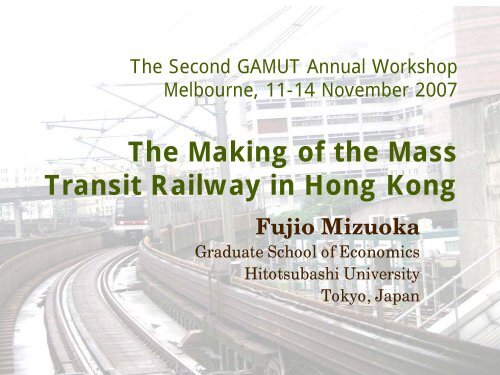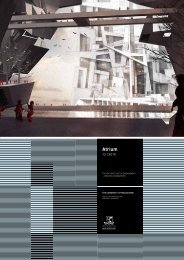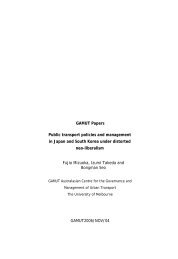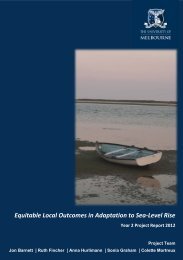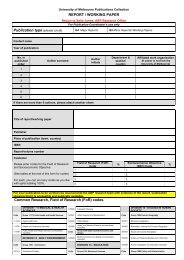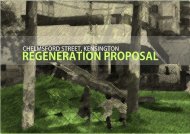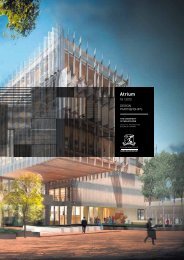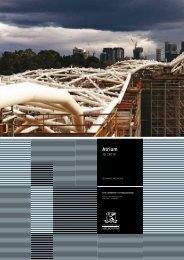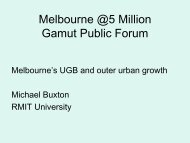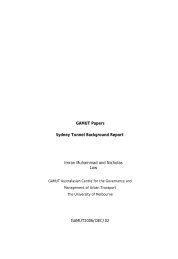The Making of the Mass Transit Railway in Hong Kong
The Making of the Mass Transit Railway in Hong Kong
The Making of the Mass Transit Railway in Hong Kong
You also want an ePaper? Increase the reach of your titles
YUMPU automatically turns print PDFs into web optimized ePapers that Google loves.
<strong>The</strong> Second GAMUT Annual WorkshopMelbourne, 11-14 November 2007<strong>The</strong> <strong>Mak<strong>in</strong>g</strong> <strong>of</strong> <strong>the</strong> <strong>Mass</strong><strong>Transit</strong> <strong>Railway</strong> <strong>in</strong> <strong>Hong</strong> <strong>Kong</strong>Fujio MizuokaGraduate School <strong>of</strong> EconomicsHitotsubashi UniversityTokyo, Japan
Bus Service <strong>in</strong> 1950s-60s• Kowloon Motor Bus Co. (KMB) served <strong>in</strong> Kowloon and<strong>the</strong> New Territories; and Ch<strong>in</strong>a Motor Bus <strong>in</strong> HK Island.• <strong>The</strong> KMB drivers were unionised under <strong>in</strong>fluence <strong>of</strong> <strong>the</strong>People’s Republic <strong>of</strong> Ch<strong>in</strong>a (PRC).• Besides ferry to cross <strong>the</strong> Victoria Harbour and go<strong>in</strong>g toand from outly<strong>in</strong>g islands, buses were sole means <strong>of</strong>transportation to commute from home to workplace,s<strong>in</strong>ce <strong>the</strong> labourers couldn’t afford private cars.• Crowded, sparse frequency and dirty coaches withcockroaches on seats. Commut<strong>in</strong>g was an ordeal and a soure <strong>of</strong> dissatisfactionamong <strong>the</strong> Ch<strong>in</strong>ese labour.
Initial Instigation:Anti-British Upris<strong>in</strong>g <strong>in</strong> 1966 and 67• Inspired by <strong>the</strong> Cultural Revolution <strong>in</strong> <strong>the</strong> PRC.• Triggered by <strong>the</strong> proposed fare hike <strong>of</strong> <strong>the</strong> British-run StarFerry, connect<strong>in</strong>g Kowloon with HK Island.• <strong>The</strong> HK Ch<strong>in</strong>ese were mobilised based on <strong>the</strong>ir discontentwith various aspects <strong>of</strong> crowded and oppressive urban life(<strong>in</strong>clud<strong>in</strong>g <strong>the</strong> condition <strong>of</strong> public transportation).• Almost <strong>the</strong> entire length <strong>of</strong> <strong>the</strong> Nathan Road was blocked by<strong>the</strong> violent upris<strong>in</strong>g, and transport system <strong>of</strong> HK wasparalysed.• Handwritten banners condemn<strong>in</strong>g British Imperialism werestuck onto <strong>the</strong> gate <strong>of</strong> Governor’s House.• After <strong>the</strong> upris<strong>in</strong>g, <strong>the</strong> colonial government studied its cause;and took measures to avoid any similar events be<strong>in</strong>g repeated<strong>in</strong> <strong>the</strong> future.
<strong>The</strong>ProposedInitialSystem
Why Japanese ConsortiumIn <strong>the</strong> British Colony?• HK British <strong>the</strong>n were <strong>in</strong> conflict with <strong>the</strong> London government ondevaluation <strong>of</strong> fiscal reserve deposit. It is believed that <strong>the</strong> colonialbureaucrats attempted to show <strong>the</strong>ir <strong>in</strong>dependence from <strong>the</strong> homegovernment.• MTR was NOT ‘luxury’ underground system entic<strong>in</strong>g former cardrivers <strong>in</strong>to public transportation, but <strong>the</strong> system to move <strong>the</strong>masses hav<strong>in</strong>g suffered from congestion problem model was notBART <strong>in</strong> San Francisco Bay Area, but <strong>the</strong> Tokyo subwaoy.• <strong>Railway</strong> technology that successfully put ATO system <strong>in</strong>to practicaluse for <strong>the</strong> bullet tra<strong>in</strong> (Sh<strong>in</strong>kansen).• Kakuei Tanaka, <strong>the</strong> Prime M<strong>in</strong>ister <strong>of</strong> Japan <strong>in</strong> early 1970s, wantedto expand <strong>the</strong> Japanese public works undertak<strong>in</strong>gs to East andSou<strong>the</strong>ast Asia.• Japan agreed to complete <strong>the</strong> task <strong>of</strong> construct<strong>in</strong>g <strong>the</strong> whole ‘<strong>in</strong>itialsystem’ at fixed price <strong>of</strong> HK$ 5 billion.• Jard<strong>in</strong>e, Ma<strong>the</strong>son & Co., <strong>the</strong> lead<strong>in</strong>g trad<strong>in</strong>g house <strong>of</strong> HK acted as<strong>the</strong> local agent.
Public Hous<strong>in</strong>gNathan Rd.IndustrialEstateF<strong>in</strong>ancial& Gov’tCentre
Property Sector as a Key factor <strong>in</strong> <strong>the</strong>MTR Project• <strong>The</strong> MTRC developed Telsford Garden over Kowloon Bay railway depot <strong>The</strong>development conta<strong>in</strong>ed 5,000 flats and a shopp<strong>in</strong>g complex.• <strong>The</strong> colonial government <strong>of</strong>fered <strong>the</strong> land <strong>of</strong> $170 million for <strong>the</strong> purpose <strong>of</strong>car barn itself and HK$165 million for <strong>the</strong> title to develop <strong>the</strong> space abovefor residential and commercial purposes, for free.• In exchange for this government <strong>of</strong>fer, <strong>the</strong> MTR Corporation issued equity<strong>of</strong> <strong>the</strong> same value and <strong>the</strong> colonial government accepted it.• In short, <strong>the</strong> Telford Garden constituted an equity <strong>in</strong>jection <strong>of</strong> HK$335million from <strong>the</strong> colonial government.• Property development raised 18.6% <strong>of</strong> <strong>the</strong> construction cost to <strong>the</strong> MTRCorporation for <strong>the</strong> Modified Initial System.• Revenue from property development depended, however, much upon <strong>the</strong>market conditions and <strong>the</strong>refore ra<strong>the</strong>r uncerta<strong>in</strong>.• <strong>The</strong> colonial government <strong>of</strong>fered unusually favourable terms for land tenure<strong>in</strong> releas<strong>in</strong>g <strong>the</strong> Crown land, especially for <strong>the</strong> years when property marketis <strong>in</strong> stagnation.• In all, <strong>the</strong> MTR Corporation developed 19 projects along <strong>the</strong> Modified InitialSystem, Tsuen Wan Extension and Island L<strong>in</strong>e put toge<strong>the</strong>r.
Telford Garden:A Big Car Barn underneath this Residential Complex
Additional Measures toAccelerate Construction and Save Costs• A penalty system to <strong>the</strong> contractors. Should a contractor fell beh<strong>in</strong>dschedule, <strong>the</strong> company was <strong>the</strong>n liable, as stipulated <strong>in</strong> a clause <strong>in</strong>contract, to pay a substantial amount <strong>of</strong> penalty which is ‘sufficientto make it hurt’.• Appeas<strong>in</strong>g <strong>the</strong> stubborn yet economically significant <strong>in</strong>dustrialists:rais<strong>in</strong>g ex gratia compensation to illegal factories from HK$20 toHK$38/sq. ft, especially when <strong>the</strong> <strong>in</strong>dustrialists contributedsignificantly to <strong>the</strong> export-oriented economic growth.• Hard-l<strong>in</strong>e measures for squatters and hawkers: <strong>the</strong> colonialgovernment, <strong>in</strong>clud<strong>in</strong>g deployment <strong>of</strong> anti-riot police force aga<strong>in</strong>st<strong>the</strong>m.• Fixed price contract <strong>in</strong> Local Currency (HK$) for roll<strong>in</strong>g stocks builtby Metro Cammell, Birm<strong>in</strong>gham, UK, with Spartan <strong>in</strong>terior andnon-upholstered seats (to avoid cockroaches).• No toilets at any <strong>of</strong> <strong>the</strong> stations. No laugh<strong>in</strong>g matter…
InitialModel <strong>of</strong>MTRRoll<strong>in</strong>gStock(built byMetroCammell,UK)
Increment Extension <strong>of</strong> L<strong>in</strong>es• October 1979: <strong>The</strong> first section <strong>of</strong> <strong>the</strong> MIS Shek Kip Mei(public hous<strong>in</strong>g area)– Kwun Tong (<strong>in</strong>dustrial area)(8.4km)• February 1980: <strong>The</strong> MIS l<strong>in</strong>e extended to Chater(downtown <strong>in</strong> HK Island)• May 1982: Tsuen Wan (a large <strong>in</strong>dustrial new town)Extension (10.75km)• May 1985 – May 1986: Island L<strong>in</strong>e (12.5km)• October 1989: Eastern Harbour Cross<strong>in</strong>g• July 1998: Airport Express (connect<strong>in</strong>g downtown with<strong>the</strong> New <strong>Hong</strong> <strong>Kong</strong> Int’l Airport) and Tong Chung L<strong>in</strong>e• August 2002: Tsuen Kwan O Extension• August 2005: Disneyland Resort L<strong>in</strong>e
MTR and Chang<strong>in</strong>g Nature<strong>of</strong> New Towns• Until 1970s, <strong>the</strong> colonial government built three largenew towns, Shat<strong>in</strong>, Tuen Mun and Tsuen Wan. Initially,<strong>the</strong>y were not connected by rapid transit with downtown,but planned as ‘self-conta<strong>in</strong>ed spatial unit’, after <strong>the</strong>British new town plann<strong>in</strong>g philosophy. Employmentopportunities (ma<strong>in</strong>ly labour-<strong>in</strong>tensive lightmanufactur<strong>in</strong>g) were created with<strong>in</strong> <strong>the</strong> new town.• Whereas <strong>in</strong> Tsuen Kwan O new town, planned <strong>in</strong> 1980s,MTR had been <strong>in</strong>tegrated <strong>in</strong>to <strong>the</strong> concept from <strong>the</strong>beg<strong>in</strong>n<strong>in</strong>g; <strong>the</strong> residents were expected to commute to<strong>the</strong> jobs us<strong>in</strong>g MTR. No manufactur<strong>in</strong>g functions wereplanned with<strong>in</strong> <strong>the</strong> new town area.
Performance <strong>of</strong> <strong>the</strong> MTRCfor <strong>the</strong> First Decade• Prudent rail operation– Steady growth <strong>of</strong> revenue and operat<strong>in</strong>g pr<strong>of</strong>it.– Efficiency <strong>of</strong> <strong>the</strong> rail operation (as <strong>in</strong>dicated by <strong>the</strong> cost andpr<strong>of</strong>it per passenger) was on <strong>the</strong> steady <strong>in</strong>crease.• F<strong>in</strong>anc<strong>in</strong>g costs put burden on <strong>the</strong> corporate f<strong>in</strong>ance– Costs for F<strong>in</strong>anc<strong>in</strong>g showed <strong>in</strong>crease especially <strong>in</strong> <strong>the</strong> first half <strong>of</strong>this period.– Due to this burden, <strong>the</strong> f<strong>in</strong>al balance <strong>of</strong> account ended up mostlywith deficit.• Fluctuat<strong>in</strong>g Property revenue– This is <strong>the</strong> outcome <strong>of</strong> fluctuat<strong>in</strong>g property market conditions.In 1981-84, <strong>the</strong> market especially stagnated due to politicaluncerta<strong>in</strong>ty beyond 1997 and concomitant emigration flow.– <strong>The</strong> fluctuat<strong>in</strong>g market trend greatly regulated <strong>the</strong> f<strong>in</strong>alpr<strong>of</strong>it/loss balance <strong>of</strong> <strong>the</strong> MTRC.
H K $ per passenger carried4.543.5FarerevenueHK$32.521.5<strong>Railway</strong>operationcosts10.501980198119821983198419851986Year19871988198919901991<strong>Railway</strong>operationpr<strong>of</strong>it
G eneralP r<strong>of</strong>it & Loss A ccont4,0003,500TotalR evenue3,000O perat<strong>in</strong>g P r<strong>of</strong>itHK$ million2,5002,0001,5001,000500Interest andF<strong>in</strong>ance C hargesPropertyDevelopm entPr<strong>of</strong>itPr<strong>of</strong>it/(Loss)0-500Year 1980 1981 1982 1983 1984 1985 1986 1987 1988 1989 1990Year-1,000-1,500
Conclusion• <strong>The</strong> MTR functioned as <strong>the</strong> ultimate solution for <strong>the</strong> ethnic cum labourstrife <strong>in</strong> colonial <strong>Hong</strong> <strong>Kong</strong> from urban spatial <strong>in</strong>tegration.• <strong>The</strong> colonial government put through this objective under strong <strong>in</strong>itiative,contrary to its ‘non-<strong>in</strong>terventionist’ claim. It sought <strong>the</strong> knowledge <strong>of</strong> <strong>the</strong>MTR from UK Consultants and Japanese Experiences.• <strong>The</strong> Japanese however did not realise <strong>the</strong> urgent need <strong>of</strong> <strong>the</strong> MTR on <strong>the</strong>part <strong>of</strong> colonial government. <strong>The</strong>y suddenly shifted <strong>the</strong>ir position to blatantshort-run pr<strong>of</strong>it motive and broke <strong>the</strong> promise.• <strong>The</strong>y <strong>the</strong>reby failed to take up <strong>the</strong> position to be <strong>the</strong> source <strong>of</strong> knowledge forrail-based urban transport <strong>in</strong> Ch<strong>in</strong>a and Sou<strong>the</strong>ast Asia.• With no prior ‘path’ to depend on, <strong>the</strong> plann<strong>in</strong>g and management <strong>of</strong> <strong>the</strong>MTR was more neo-liberalist and cost effective than urban railwaymanagement elsewhere.• <strong>The</strong> prudent yet labour-hostile rail management provided HK with asusta<strong>in</strong>able rail-based urban transport network as a result.• <strong>The</strong> MTR <strong>in</strong>ternalised much <strong>of</strong> externalities that <strong>the</strong> newly-built railway hadgenerated, through a number <strong>of</strong> property development projects along <strong>the</strong>l<strong>in</strong>e, yet this exposed <strong>the</strong> balance-sheet <strong>of</strong> <strong>the</strong> MTRC to <strong>the</strong> mercy <strong>of</strong> generalproperty market trend.• <strong>The</strong> advent <strong>of</strong> MTR had effect to change former concept <strong>of</strong> new town from<strong>the</strong> self-conta<strong>in</strong>ed <strong>in</strong>to that dependent more on <strong>the</strong> external economicfunctions.


